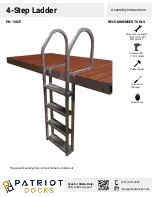
102-61029/410 - REV. 5 - 09-2020
10
Extending the ladder (partially)
Place the ladder on a sturdy, level surface suitable on which to use the ladder. Release the strap that secures
the ladder in the “storage configuration”. Place your foot on the bottom rung (closest to the ground). With both
hands, pull up the 3rd rung – counting from the ground. Lift ladder off the ground very slightly – stabilizers will
automatically telescope out to the correct extension.
The green indicator on front of each stabilizer will
confirm that they are locked in place
. Place your foot on the bottom rung to hold the ladder in place. With
both hands pull up on the rung that you determine will be the highest point to which you would like to extend
the ladder. Extend each rung until it is locked in place. You will hear an audible click and see a green indicator
on the rung below confirming that section is fully extended and locked. Continue extending the ladder all the
way up. Once fully extended, each section should show a green lock indicator. Visually inspect the ladder for
any damage, debris and ensure that all open sections are locked.
Extending the ladder (full working height)
Place the ladder on a sturdy, level surface suitable on which to use the ladder. Release the strap that secures
the ladder in the “storage configuration”. Place your foot on the bottom rung (closest to the ground). With both
hands, pull up the 3rd rung – counting from the ground. Lift ladder off the ground very slightly – stabilizers
will automatically telescope out to the correct extension.
The green indicator on front of each stabilizer will
confirm that they are locked in place
. Place your foot on the bottom rung to hold the ladder in place. With
both hands pull up on the rung that you determine will be the highest point to which you would like to extend
the ladder. Extend each rung until it is locked in place. You will hear an audible click and see a green indicator
on the rung below confirming that section is fully extended and locked. Continue extending the ladder all the
way up. Once fully extended, each section should show a green lock indicator. Visually inspect the ladder for
any damage, debris and ensure that all open sections are locked.
Closing the ladder
Great care should be used when retracting the ladder. Do not place any part of your body incliding hands,
fingers or thumbs, on, or between rungs or couplings above the closing rung. Ensure that you are on a sturdy
level surface. Hold the ladder upright. Place thumbs on the release mechanism located on the second to
bottom rung from the ground. Push each release mechanism inward one at a time to unlock the ladder while
securing the ladder with the other hand. The entire ladder is now completely unlocked (DO NOT CLIMB
LADDER AFTER PERFORMING THIS PROCEDURE). Due to our «soft closing» system, the rungs may
need slight guidance while retracting. Attach the strap that secures the ladder around the top rung. Push the
stabiliser bars inward to retract each side to its «storage configuration».
Locked
Locked
Lightning latch
Un-Locked
Un-Locked
Proper hand
placement
Improper hand
placement































